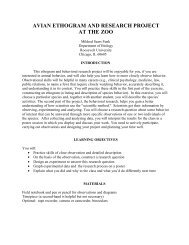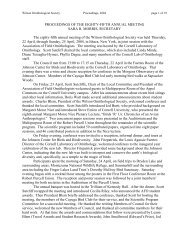Available now - Wilson Ornithological Society
Available now - Wilson Ornithological Society
Available now - Wilson Ornithological Society
You also want an ePaper? Increase the reach of your titles
YUMPU automatically turns print PDFs into web optimized ePapers that Google loves.
WOS 2010 ~ ABSTRACTS p. 34<br />
P25 S Comparing female characteristics to egg & yolk size in the Chilean Swallow (Tachycineta meyeni). Mitch<br />
Walters, Marcela Liljesthrom, and Caren Cooper, Dept. Ecology and Evolutionary Biology, Cornell Univ., Ithaca ,<br />
NY 14850, Centro Austral de Investigaciones Cientificas, CADICONICET, Ushuaia, Tierra del Fuego, Argentina,<br />
and Cornell Lab of Ornithology, Cornell Univ., Ithaca, NY 14850<br />
Variation in female and environmental characteristics can lead to variation in egg composition for a variety of bird<br />
species. We investigated the relationship between female attributes and egg/yolk size in Chilean Swallows<br />
(Tachycineta meyeni) breeding in Ushuaia, Argentina. We examined whether egg/yolk size varied with female<br />
attributes, varied with egg-laying sequence, and/or showed any seasonal trends. We carried out our investigations<br />
using egg measurements collected in the field as well as egg and yolk measurements extracted from digital<br />
photographs taken in the field with a standardized egg candler, the ovolux. If egg dimensions extracted from<br />
photographs were comparable to field measures, then the ovolux could reduce egg handling and breakage in the<br />
field. Based photo-derived data, both egg and yolk dimensions decreased as the season progressed, though we could<br />
not detect these changes based on field measurements. The nature of the correspondence between field values and<br />
digital image values suggest some refinements to the ovolux methods may be needed.<br />
P26 S Bacteria and fungi in the plumage of birds of prey. Jordan S. Kalish and Edward H. Burtt, Jr., Dept. Zoology,<br />
Ohio Wesleyan Univ., Delaware, OH 43015<br />
Studies of bacteria and fungi in the plumage of birds have focused on songbirds. We report the first data on hawks<br />
and owls. Microbial samples were collected from 18 raptors of six species living at Ravensbeard Wildlife Center,<br />
Saugerties, NY. Each bird was sampled with five types of media. All were incubated for 48 hours, after which the<br />
spore-forming rods, including Bacillus subtilis and B. lichenifomis, non-spore forming rods, cocci and fungi were<br />
counted. Over 60 colonies of B. licheniformis occurred on five plates from two of the four species of owls and two<br />
Red-tailed Hawks (Buteo jamaicensis). Owls had more spore-forming rods and more total bacterial colonies per bird<br />
than the Red-tailed Hawks or the single Broad-winged (B. platypterus) Hawk. Eastern Screech Owls (Otus asio)<br />
averaged 441.5 more spore-forming rod colonies than Great Horned Owls (Bubo virginianus), 691.7 more than<br />
Barred Owls (Strix varia), 1508.0 more than Long Eared Owls (Asio otus). Male and female hawks and owls had<br />
similar numbers of plumage microorganisms. The longer a raptor was in captivity the more bacteria were in its<br />
plumage. Over 40 months the number of colonies in the plumage increased about four and a half times. While these<br />
are the first data on raptors, all birds were living in captivity. To understand the plumage ecosystem of raptors we<br />
will need to capture and sample wild raptors. Such samples will not only tell us about the plumage ecosystem, but<br />
may also provide insights into the effect of captivity on the system.<br />
P27 S Seasonal changes in maintenance behavior of the House Sparrow (Passer domesticus). Aubrey Alamshah and<br />
Edward H. Burtt, Jr., Dept. Zoology, Ohio Wesleyan Univ., Delaware, OH 43015<br />
The percentage of House Sparrows (Passer domesticus), and with feather-degrading bacilli is significantly greater in<br />
the winter than the spring and summer (Burtt and Ichida, 1999). One possible explanation is that the sparrows<br />
engage in less maintenance behavior in winter than in summer. There are several reasons why this might be: higher<br />
energy demands, which would necessitate more time foraging; shorter days; colder temperatures and lower humidity<br />
so that feather-degrading microorganisms are a lower risk to the plumage than in warm, humid weather (Burtt and<br />
Ichida 2004). However, seasonal changes in the maintenance behavior of passerines is a largely unstudied subject.<br />
House Sparrows bath, dust bath, head scratch, bill wipe, sun, and preen (Summers-Smith 1963, Anderson 2006). We<br />
observed changes in the form and frequency of the behavior in House Sparrows held in an outdoor aviary. We<br />
caught twelve House Sparrows in Ashley, Ohio. We banded each bird with an aluminum band and a unique<br />
combination of color bands, measured the weight and wing length, examined condition of their feathers, and<br />
sampled their plumage for microorganisms. The birds were then released into an outdoor aviary, 8m x 4.5m x 2.5m.<br />
We observed the birds for 2-3 hours/week, noting the occurrence of maintenance behavior in each individual, its<br />
sequential organization, and bout length. The study is still in progress, but we will compare changes in maintenance<br />
behavior and time allotted to such behavior throughout the seasons. Seasonal differences in the behavior may<br />
explain seasonal variation in the plumage microbiota of the House Sparrow.<br />
P28 S The fox in the henhouse: responses of chickens (Gallus domesticus) to the scent of a predator. Andrew C.<br />
Alba and Gregory B. Cunningham, Dept. Biology, St. John Fisher College, Rochester, NY 14618<br />
Domestic chickens (Gallus domesticus) are often used as a model species in testing bird olfaction. Previous studies<br />
have indicated that domestic chicks can discriminate between various odors, are attracted to familiar odors, and use<br />
olfactory cues during food selection. Additionally, studies have indicated that olfaction plays an important role in<br />
predator recognition in a variety of songbirds. It has yet to be demonstrated, however, whether chickens can detect<br />
predators using olfactory cues. To address this, we tested 1-2 day old naïve chicks with undiluted fox urine and<br />
found that they were able to detect this scent. This could potentially signify that an innate fear response is present in<br />
domestic chicks and is initiated upon exposure to a predator’s scent. Furthermore, given the intensity with which





